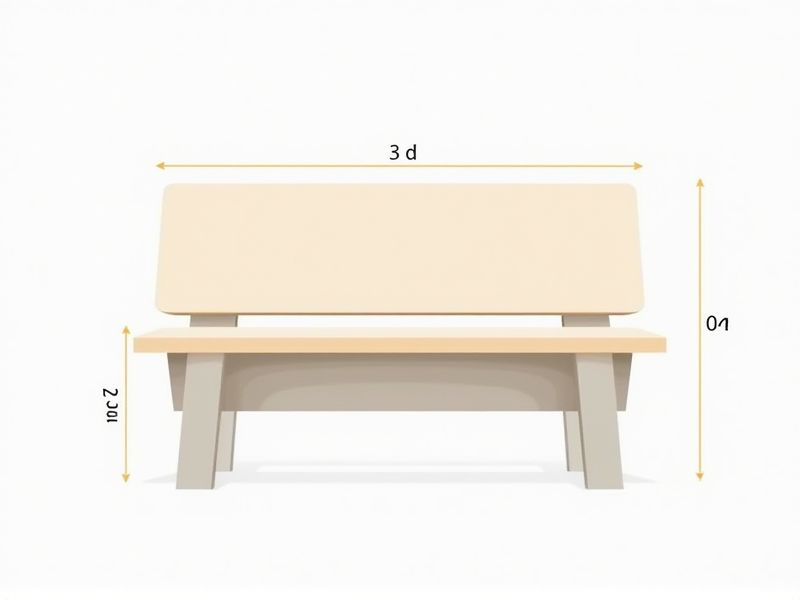
When planning for a comfortable bench seat, it's important to keep standard dimensions in mind. A typical bench seat is about 17 to 19 inches high from the ground, which allows most people to sit comfortably with their feet flat on the floor. The seat depth usually ranges between 15 and 18 inches for indoor seating, or up to 20 inches for outdoor benches where people may want to lounge. For width, allowing at least 18 to 24 inches per person ensures adequate personal space and comfort.
Bench Seat Height
The standard bench seat height typically ranges from 16 to 18 inches, making it comfortable for most individuals to sit and rise with ease. This dimension is particularly important in public spaces, where accessibility for people of all ages and abilities is crucial. When selecting or designing a bench seat, consider the ergonomic implications of seat height on user comfort and posture. If you're customizing a bench, ensure that the height aligns with the intended audience to promote a positive seating experience.
Seat Depth
The standard seat depth for a bench seat typically ranges from 15 to 20 inches, ensuring comfortable seating without compromising space efficiency. An optimal seat depth allows users to sit back in a relaxed position while providing adequate support for thighs and lower back. For those considering custom designs, adjusting the seat depth may enhance usability, particularly for taller individuals who require more legroom. When selecting a bench seat, it's essential to measure the available space and ergonomics to accommodate both comfort and style.
Seat Width
The standard bench seat typically measures between 48 to 60 inches in width, accommodating two to three passengers comfortably. For maximum user comfort, a seat width of at least 18 inches per person is recommended. This width allows for enough personal space while ensuring that the seating arrangement remains compact and functional. When selecting a bench seat, consider the overall design and space available in your area to enhance both aesthetics and usability.
Backrest Height
The standard height for a bench seat backrest typically ranges from 14 to 20 inches above the seat surface, ensuring adequate lumbar support. A backrest height of around 18 inches is commonly recommended for optimal comfort and posture. For residential settings, a backrest angle of 90 to 100 degrees is ideal, promoting a natural spine alignment. When selecting a bench seat, consider your users' needs, especially if it will be used frequently for extended periods.
Armrest Height
The standard height for bench seat armrests typically ranges from 24 to 32 inches above the ground, depending on the specific design and intended use. This measurement ensures optimal comfort and support for various users, allowing for relaxed posture during extended seating periods. When considering bench seating for public spaces or waiting areas, a height of 27 to 29 inches is often ideal for accommodating most users comfortably. Selecting the right armrest height enhances the overall usability and accessibility of your seating arrangement.
Cushion Thickness
The standard bench seat typically prioritizes cushion thickness between 3 to 6 inches, balancing comfort and support. A thicker cushion often enhances your seating experience, providing better pressure distribution and reducing fatigue during prolonged use. For maximum durability, many bench seats utilize high-density foam, which maintains its shape and resilience over time. Choosing the right cushion thickness ensures not only comfort but also the longevity of your seating arrangement.
Leg Spacing
When selecting a bench seat, leg spacing is critical for comfort and functionality, with an optimal width of 17 to 20 inches recommended. This spacing allows individuals to sit without feeling cramped, supporting a relaxed posture. Ergonomic designs often feature tapered or contoured edges to enhance legroom, preventing discomfort during extended sitting periods. Ensuring proper leg spacing can significantly improve user experience, making your seating arrangement more inviting and practical.
Material Specifications
The material specifications for a standard bench seat typically include durable components such as high-density polyethylene (HDPE) for the seat surface, which offers UV resistance and easy maintenance. A robust steel frame, often coated with a weather-resistant powder finish, ensures structural integrity and longevity, commonly rated to withstand weights up to 1,000 pounds. The use of stainless steel hardware is essential for resisting corrosion, particularly in outdoor environments. For comfort, the bench often features ergonomically designed contours, with dimensions usually measuring around 48 inches in length, 20 inches in depth, and 18 inches in height.
Weight Capacity
A standard bench seat typically supports a weight capacity ranging from 400 to 800 pounds, making it suitable for multiple users at once. It's essential to consider the construction materials; hardwood frames often provide better durability compared to particleboard. Many designs incorporate reinforced joints and sturdy legs to ensure stability and safety. When selecting a bench seat, make sure to check the specific weight rating to ensure it meets your requirements.
Upholstery Options
The standard for bench seats primarily revolves around upholstery options that enhance both comfort and durability. High-quality materials, such as leather and performance fabrics, are often chosen for their resistance to wear and ease of cleaning, making them ideal for various environments. A variety of colors and textures are available, allowing for customization to fit specific aesthetic preferences and decor styles. Your selection of upholstery can significantly impact the overall ambiance and functionality of the space, ensuring that the bench seat meets both practical and visual demands.
